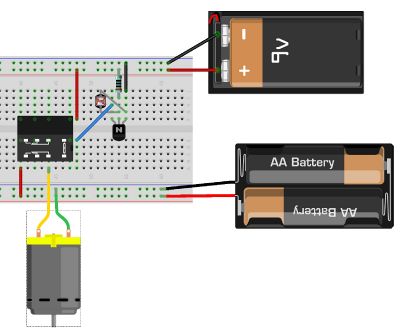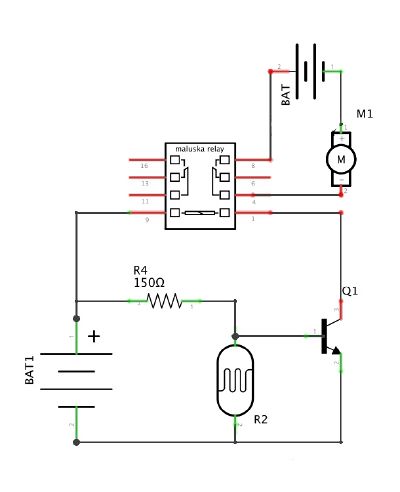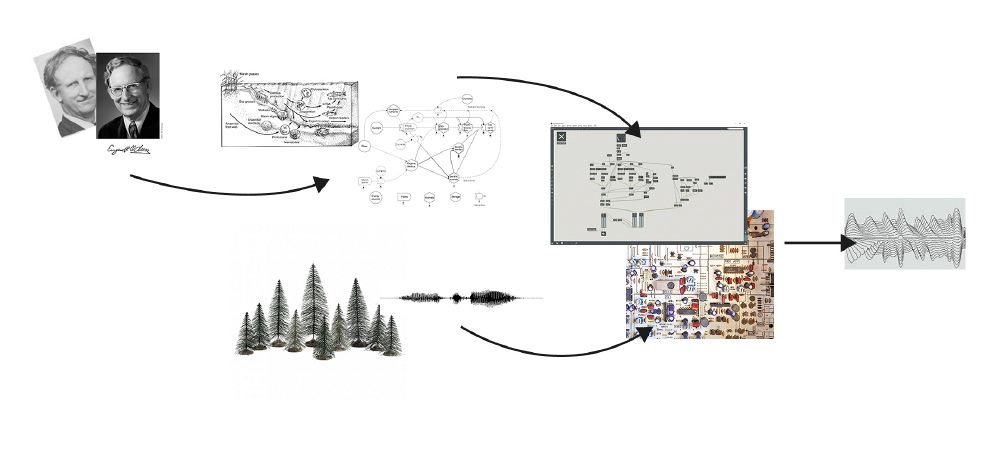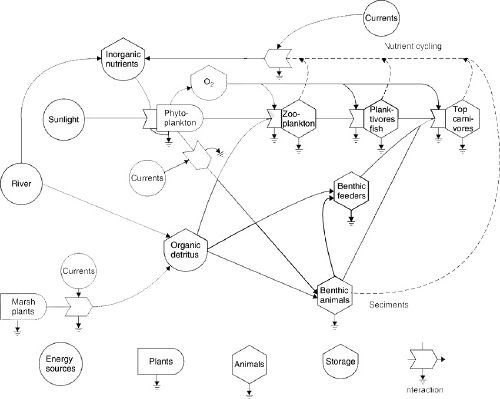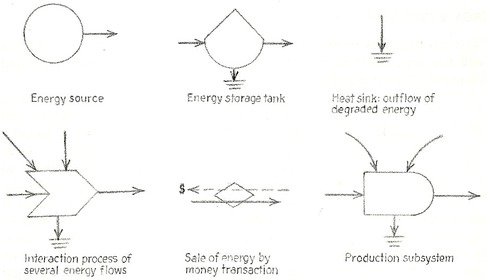Listening to an ecosystem
Thoughts on day and night
Content
- Workshop Wolfgang Spahn
- Workshop Špela Petrič
- Project Proposal
- Project Documentation
Project Proposal
My attention is focused on the concept of the ecosystem and the system dynamics of the early 50s.
Howard and Eugene Odum established the idea that the entire ecosystem strives for a steady equilibrium and, as long as mankind respects it, will settle again and again.
To explain this idea, Howard Odum had developed a system that transfers each organism into electronic components that either releases or takes energy and translate the ecosystem into a series of feedback loops.
Although this concept of the ecosystem has not proved true, it is now the basis of our financial systems and has already led to several crises around the world.
The critical point in Howard Odum's work is the strong simplification of his system. This led to the success of his experiments by simply ignoring disturbing factors.
I would like to try to rebuild such a system to better understand it. I am more interested in the aspect of translating nature into technology than in our financial system. Therefore, I would like to choose a relatively small system to which I have access to the analogue world. For example, a lake or stream, a certain type of forest or even just small symbiotic structures within a system. It should be something that is available to me for expeditions and research in the vicinity.
I'm interested in whether this system and its equilibrium can be reconciled. If each organism is a specific electronic component, it also makes a specific noise. Is it possible to identify the patterns of the ecosystem and how does that sound for all the actors together to produce equilibrium?
Another machine that interests me on this subject is the one in which you can feed the sound, i.e. field recordings, from the selected range and edit it according to the parameters of the Odum system. How is the sound from nature opposed to the sound of the machine?
For the second project I would transfer the machine into a digital system (e.g. MaxMas/PD) that would make it easier to transfer the sound and make more flexible changes.
For the presentation of the work, I can imagine an exhibition in which on the one hand the machines and other working models created on the way to them are shown. The second machine I have described can also be described in a video work in which one can establish a stronger connection to the analyzed place and compare the two sound worlds.
drawings/sketches
Here you find the description of my project in a sketch:
These are sketches from Howard Odums translation of an ecosystem and Jay Forrester concept of other systems:
to do's
- get a better understanding of how the systems of the Odums work
- find out components I have to use
- find a system or piece of a system that I can use for my idea
- start to experiment with own little models
These points have to be done before MusicMakers Hack Lab at CTM! (28.01.2019)
- find a nice exhibition space to showcase the finished work in March
Fundamentals of Ecology
- First law of thermodynamics: Energy may be transformed from one type into another but is never created or destroyed.
- Second law of thermodynamics: No progress involving an energy transformation will spontaneously occur unless there is a degradation of the energy from a concentrated form into dispersed form.
- One example regarding one single being: A being takes in chemical potential energy of food and converts a large part into heat to enable a small part of the energy to be reestablished as the chemical potential energy of new protoplasm1.
- First, one has to consider the total amount of energy within an ecosystem and then think of the smaller amounts that flow through an organism.
readings:
"the limits to growth"- Club of Rome
"Fundamentals of Ecology" - Eugene P. Odum (Especially Chapter 3)
"Cybernetics" - Norbert Wiener
Explanations and other sources/information
1Protoplasma (wikipedia)
Alfred J. Lotka
Erwin Schrödinger
Project Documentation
The actual project developed differently from what I planned to. This is why you find a huge difference in between the proposal chapter and this one here.
But the descriptions will not be discarded. They will be used for upcoming projects, like in my thesis.
Still, the work according to this class is based on the described thoughts, ideas and readings:
Despite various other cycles that influence processes in ecosystems, the day/night rhythm is very present and
divides all processes into two time domains.
When researching the Odum's approach, it must be noted that these cycles have been completely ignored.
In general, this is a big criticism of their work, which I would like to work out with "Thoughts on day and night".
For a quick impression on the work
watch the video documentation.
text
What you see here is the confrontation with our ecosystem,
with views from recent decades, with a tree and with the flow of energy.
Can you see, feel, hear the energy?
If it were up to the brothers Howard and Eugene Odum,
which coined the term ecosystem in the 1960s, you should now see here a
perfect analysis tool.
But over the years, it has been shown time and again that their simplifications
and mechanical trains of thought cannot be equated with the image of reality
neither on a scientific level nor on an emotional level.
Nevertheless, their research has made a decisive contribution to our
understanding of the interrelationships in nature and continues to provide a
large playing field for our own experiments.
So what you see, hear and experience here is the proportion of sunshine
hours on 21st March 2011 compressed to 2.4 minutes. This date is the day of
the forest in the year of the forest. The various circuits, one purple, one
orange, receive their energy from the light, react to it and collect it for
processes at night.
images
technical explanation
the work consists of two parts.
There is a stepper motor that is controlled by an Arduino and powered by a 12V power supply.
The motor is rotation very slow so that it takes 2:40 minutes for one whole rotation.
Attached to the motor is a translucent disc. (see image).
The rotating disk shades a pin spotlight for an amount of time that is equal to the night hours on the 21st March 2011.
During daytime/sunshine hours there are always sections which simulate the shading by clouds on this day.
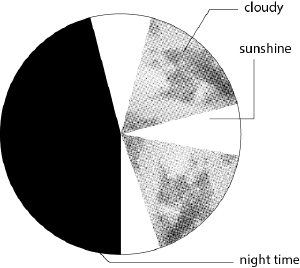
The pin spot is lighting on the actual machine of this project.
It consists of two electronic circuits (see image).
The first circuit is powered by the light of the pin spot. It transforms the light into electronic energy
by using small photovoltaic panels.
The energy powers a 555 timer, that then plays a sound.
The frequency of the sound is depending on the intensity of light shining on the circuit, which is detected by a photocell.
this sound stands for the activities that are taking place within an ecosystem
(I am focusing on plants, basically a tree) during the daytime.
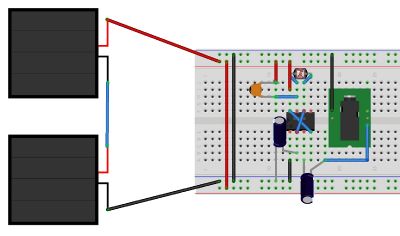
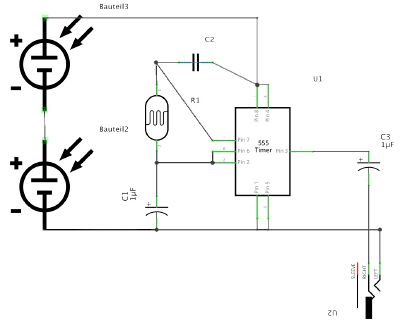
The second circuit is focusing on the processes at nighttime in the darkness.
A photocell detects the amount of light and triggers a relay as soon as it gets dark.
The relay closes then another circuit the powers a dc motor on which some metal wool is attached.
While rotating the wool touches a piezo element connected to a sound mixer and speakers.
The processes at night are represented not only by the visible movement of the engine, but also on an auditory level.
